Wearables, mHealth applications and patient monitoring have become important tools for physicians who wish to foster strong relationship with their patients. Without these, physicians still have to rely on manual processes which lead to inefficiency and medical errors, impacting care quality and treatment cost. However, since “every rose has thorns”, we can’t deny the fact that these technologies have given rise to certain challenges which need to be addressed, and “Interoperability” is one of the challenge.
Patient digital records are spread across diverse applications and interoperability between these systems have become a common challenge for healthcare providers. Despite several attempts by the US government to facilitate interoperability by promoting electronic health record (EHR) adoption, there are still persistent gaps in EHR adoption by non–primary care specialties and physicians in solo practices among others.
While many healthcare organizations have realized that maximized interoperability leads to long term sustainability of patient engagement, many few implement systems that meet the specifications as set by the governmental authorities. According to Dominick Bizzarro, RPh, Managing Director, HealthShare, at InterSystems, Cambridge, Mass, “Having comprehensive, consistent, patient data – both structured and unstructured – is a strategic must-have for healthcare organizations interested in engaging providers and patients.” So, how interoperability aids patient engagement and what can be done to optimize this?
What is Interoperability and Why is it important?
In healthcare, interoperability is the ability of two or more systems or applications to exchange, use and represent data securely and easily. Patients frequently obtain health care services from multiple healthcare providers, including independent physicians, hospitals, post-acute care facilities, pharmacies and labs among others. In order to deeply comprehend patients’ conditions and provide the best care possible, it is critical that all the EHRs associated with a patient must be shared among different healthcare providers and with patients themselves, especially, for those who are suffering with chronic illness.
Patient Engagement is about personalized medicine. An engaged patient actively work with their healthcare providers to set goal to, stay healthy, manage conditions, and follow plans to maintain their own health and wellness. Interoperability plays a very crucial role in enhancing patient engagement. Easy access to medical records through integrated health records is critical in order to improve and accelerate treatment for the chronically ill. In addition to that, easy access to medical records help the physicians with accurate diagnosis, thus leading to better care and lower risks of medical errors.
Some of the widely used healthcare applications are built before APIs and cloud concept were even discovered. Although newer generations applications are built with interoperability in mind, but getting the whole ecosystem to play well with each other still remains a challenge.
Modern healthcare systems need to prepare themselves in order to help healthcare providers improve the quality and efficiency of their service based on complete EHRs and insights from real-time analytics. Undoubtedly, there has been an increased focus on developing new interoperable solutions for the healthcare market in the recent years, but it still seems far away from the wide acceptance.






